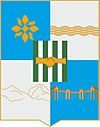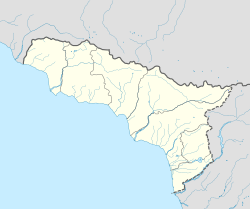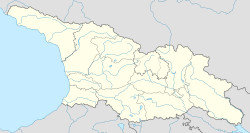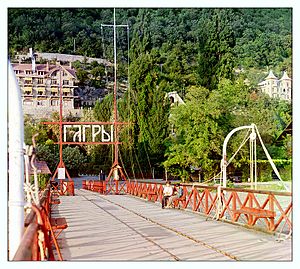Gagra facts for kids
Quick facts for kids
Gagra
|
||
|---|---|---|
|
Town
|
||
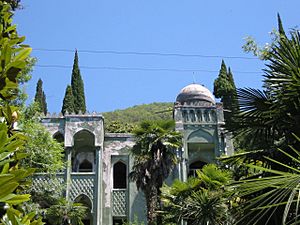
Old Gagra
|
||
|
||
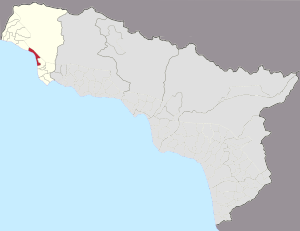
Location of Gagra in Abkhazia
|
||
| Country | Georgia | |
| Partially recognized independent country |
||
| District | Gagra | |
| Population | ||
| • Estimate
({{{pop_est_as_of}}})
|
12,002 | |
| Time zone | UTC+3 | |
| Climate | Cfa | |
Gagra is a town located in Abkhazia, a region that is part of Georgia. It stretches for about 5 kilometers along the northeast coast of the Black Sea, right at the base of the Caucasus Mountains.
Gagra has a warm, humid climate, which made it a very popular health resort in the past. Many people visited it during the time of the Russian Empire and the Soviet Union. In 1989, Gagra had a population of 26,636 people. However, this number has become much smaller due to a war and other changes that happened in the 1990s.
Gagra is the main town of the Gagra District. It is in the western part of Abkhazia. The Psou River forms the border between Gagra and Krasnodar Krai in Russia.
Contents
What's in a Name?
The name "Gagra" has a few possible meanings. Some Georgian experts believe it comes from the word Gakra, which means "walnut" in the Svan language.
Another idea comes from a Soviet writer named Bondaryev. He thought the name came from a local family or clan called Gagaa. A different expert, V. Kvarchija, suggests that Gagra means "the holder of the coast" in the Abkhaz language. This makes sense because Gagra was known as Kakara or Kakkari on old maps.
A Look Back in Time
Early Days
Gagra started as an ancient Greek settlement called Triglite. It was part of the kingdom of Colchis. People from Greece and Colchis lived there. Later, the Roman Empire took control and renamed the town Nitica. Because of its important location, the Romans built strong defenses around the town. Even so, it was often attacked by groups like the Goths. Gagra and the surrounding area remained part of the Byzantine Empire for a long time.
Trade and Decline
Gagra became a very important trading center. Merchants from Genoa and Venice traded goods like wood, honey, wax, and even slaves there. The name "Gagra" first appeared on a map in 1308. This map was made by an Italian named Pietro Visconti.
In the 16th century, the Ottoman Empire took over Gagra and other parts of western Georgia. The European traders left, and the town began to decline. Many local people moved away into the mountains. By the 1700s, Gagra was mostly a small village surrounded by forests and unhealthy swamps.
Under Russian Rule
Gagra's luck changed in the 1800s when the Russian Empire expanded into the region. The swamps were drained, and the town was rebuilt around a new military hospital. However, not many people lived there yet. In 1866, only about 600 people were recorded as living in Gagra.
The town suffered during the Russo-Turkish War, 1877-1878. Turkish troops attacked and destroyed Gagra, forcing people to leave. But Russia won the war and rebuilt the town again.
In 1904, Duke Alexander of Oldenburg, a member of the Russian royal family, discovered Gagra. He saw that its warm climate was perfect for a fancy resort. He got a lot of money from the government and built a beautiful palace for himself. He also built other unique buildings and created a park with tropical trees, parrots, and monkeys to make it feel exotic. At first, the resort was not very popular, but it later attracted more tourists.
Gagra in Soviet Times
During the Russian Revolution of 1905, a local group briefly set up a revolutionary government in Gagra. They called it the Republic of Gagra, but it didn't last long. The First World War then badly hurt Gagra's tourism. After the Russian Revolution of 1917, the Bolsheviks took control of the town. Gagra became part of the new Soviet Union, within the Georgian SSR.
In 1919, the Bolshevik leader Vladimir Lenin ordered that Gagra become a "worker's resort." This meant the fancy resort built by Oldenburg was taken over by the state. It became a popular vacation spot for Soviet citizens. During World War II, it was used to help wounded soldiers recover. After the war, many state-run health centers were built there. Gagra grew into a big part of what was called the "Soviet Riviera." A popular movie in 1985, Winter Evening in Gagra, made the resort even more famous.
Gagra After the Soviet Union
In the late 1980s, tensions grew between the Georgian and Abkhazian communities. A war broke out between 1992 and 1993. Gagra and the Abkhazian capital, Sukhumi, saw heavy fighting and were badly damaged. During this time, many people had to leave their homes. Even today, many people who left during the war have not been able to return.
Important Landmarks
Here are some of the main historical places to see in Gagra:
- Ruins of the Abaata Fortress (built between the 4th and 5th centuries AD)
- A church from the 6th century, known as the Church of Gagra
- Marlinsky defensive tower (built in 1841)
- The 19th-century palace of the Prince of Oldenburg
See also
 In Spanish: Gagra para niños
In Spanish: Gagra para niños


